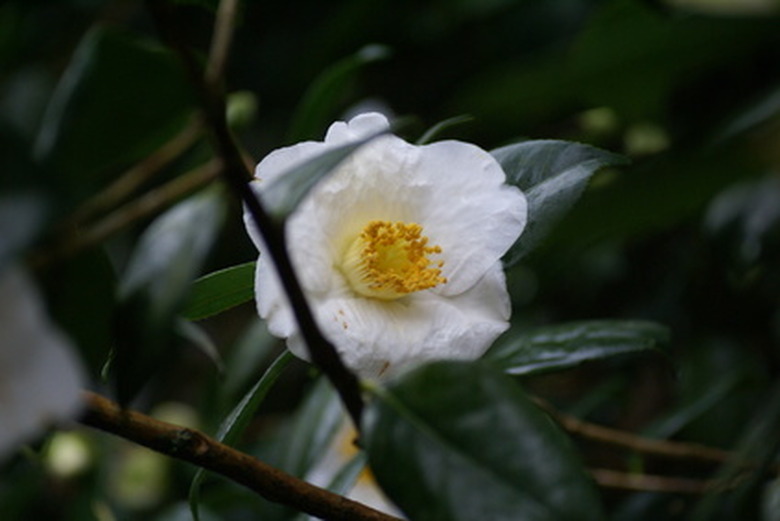Varieties Of Camellia Sasanqua
The sasanqua (Camellia sasanqua) is an upright to spreading large shrub to small tree that matures at 15 to 20 feet tall and 10 feet wide. The jade-green leaves are evergreen and make a beautiful backdrop to the white to pink or red flowers that reliably occur in fall and early winter months. Native to Japan, sasanquas are grown in USDA winter hardiness zones 7 through 9. Plant them in an acidic, organic-rich soil that is moist and well-draining. Partial sun or shade is okay, but if soil is shaded by mulch and roots kept cool, a sasanqua camellia can thrive in full-sun exposures. Dozens of varieties of sasanquas exist.
The sasanqua (Camellia sasanqua) is an upright to spreading large shrub to small tree that matures at 15 to 20 feet tall and 10 feet wide. The jade-green leaves are evergreen and make a beautiful backdrop to the white to pink or red flowers that reliably occur in fall and early winter months. Native to Japan, sasanquas are grown in USDA winter hardiness zones 7 through 9. Plant them in an acidic, organic-rich soil that is moist and well-draining. Partial sun or shade is okay, but if soil is shaded by mulch and roots kept cool, a sasanqua camellia can thrive in full-sun exposures. Dozens of varieties of sasanquas exist.
Bonanza
The strong, sturdy branches of the 'Bonanza' cultivar of sasanqua create a shrub that matures at 6 to 10 feet tall and 3 to 6 feet wide. Rose-red to red flowers that are somewhat peony-like in form appear in fall to early winter. These flowers with gold stamens aren't overly large, but are produced in abundance among the leaves–often flowers are open and display many developing buds, foreshadowing a long blooming season and display.
- The sasanqua (Camellia sasanqua) is an upright to spreading large shrub to small tree that matures at 15 to 20 feet tall and 10 feet wide.
- The strong, sturdy branches of the 'Bonanza' cultivar of sasanqua create a shrub that matures at 6 to 10 feet tall and 3 to 6 feet wide.
Mine-Yo-Yuki
Double rows of white waxy petals form small flowers all across the somewhat weeping branches on the sasanqua variety 'Mine-Yo-Yuki'. The blossoms also are mildly fragrant and eventually open so wide as to reveal a tuft of yellow stamens. A vigorously growing plant with smaller-sized leaves in comparison to most other sasanqua shrubs, the branching architecture of 'Mine-Yo-Yuki' develops a spreading, almost willow-like habit. It will grow to about 8 feet tall and equally as wide.
Sparkling Burgundy
With an upright mature shape with irregular branching, 'Sparkling Burgundy' produces peony-like flowers that are ruby-red with a lavender sheen. Gold stamens are scattered among the petals to create a rustic but beautiful color contrast. This cultivar grows anywhere from 8 to 20 feet tall and 6 to 15 feet wide. Pruning in late winter can help create the size shrub you desire.
- Double rows of white waxy petals form small flowers all across the somewhat weeping branches on the sasanqua variety 'Mine-Yo-Yuki'.
- The blossoms also are mildly fragrant and eventually open so wide as to reveal a tuft of yellow stamens.
Shishigashira
The variety 'Shishigashira' is a lower-sized plant. Slowly maturing to about 4 feet tall and 6 feet wide, its ornamental forte is the peony-form flowers with semi-double to double (many extra) petals with a waxy texture. Beginning to bloom in early fall and continuing to early winter, 'Shishigashira' flowers are a deep red-rose color, very vibrant to the eye.
White Dove
'White Dove' also is a comparatively lower, broader-forming selection of sasanqua. It grows 3 to 6 feet tall and 6 to 8 feet wide, and branch-tip pruning in late winter can make the plant remain more prostrate in form. Its white, peony-like flowers occur among the leaves on branch ends anytime from mid-autumn to mid-winter.
References
- "A-Z Encyclopedia of Garden Plants"; Christopher Brickell and H. Marc Cathey, eds.; 2004
- Floridata: Camellia Sasanqua Gallery
